Ruskin's Standard & Reference series (1872)
Exemplary works of art. In the catalogue of the Reference series, items marked 'M' are drawings "by my own Hand" (by Ruskin), P are photographs, E engravings and A by Ruskin's Assistant, Arthur Burgess.

-
 176. Rameses III. and suppliants.
176. Rameses III. and suppliants.
-
 177.
Chariot of Rameses III.
177.
Chariot of Rameses III.
-
 178.
Encampment of Rameses III.
Rosellini,
Tavole, tom. i. pl. 83.
See the text, tom. iv.
p. 119, &c.
178.
Encampment of Rameses III.
Rosellini,
Tavole, tom. i. pl. 83.
See the text, tom. iv.
p. 119, &c.
-
 179.
Menepthah II. adoring Phre.
Rosellini, Tavole, tom. i. pl. 118.
Text, tom. iv.
p. 305.
179.
Menepthah II. adoring Phre.
Rosellini, Tavole, tom. i. pl. 118.
Text, tom. iv.
p. 305.
-
 180. Rameses IV. adoring Isis and Osiris.
Rosellini, Tavole, tom. i. pl. 145.
Text, tom. v.
p. 104.
180. Rameses IV. adoring Isis and Osiris.
Rosellini, Tavole, tom. i. pl. 145.
Text, tom. v.
p. 104.
These plates, of which 101 and 102 are portions of 103 enlarged, represent, accurately enough for general intelligibleness, the manner of fine Egyptian art in coloured intaglio. And the study of the development of this form of decoration will introduce us to every condition of good Gothic sculpture.
Observe, respecting these plates of Rosellini, that the colours are in great part conjecturally restored; slight traces of the original pigments, and those changed by time, being interpreted often too arbitrarily: and that the beauty or vulgarity of any given colour, much more that of its harmony with others, is determined by delicacies of hue which no restorer can be secure of obtaining, and few attempt to obtain.
The student, therefore, can only depend on these plates for the disposition of the colours, not for their qualities.




